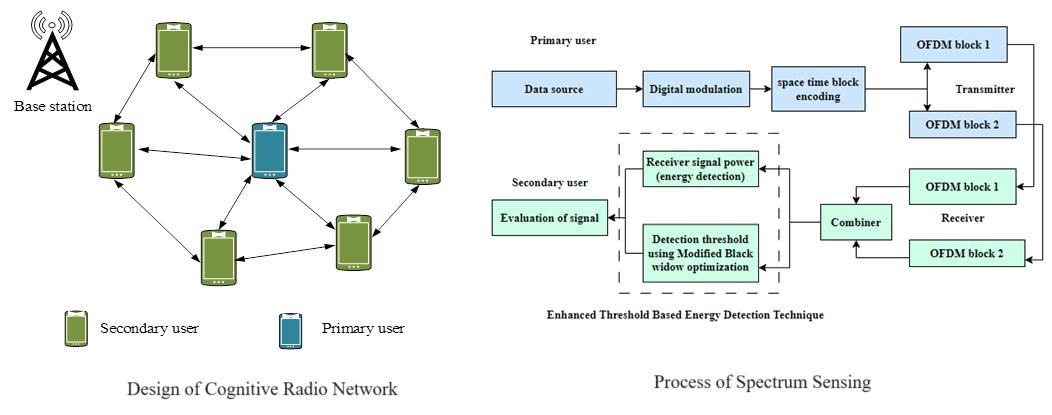 Open Access
Open Access
ARTICLE
Modified Black Widow Optimization-Based Enhanced Threshold Energy Detection Technique for Spectrum Sensing in Cognitive Radio Networks
1 School of Computing, SASTRA Deemed University, Thanjavur, 613401, India
2 School of Electrical & Electronics Engineering, SASTRA Deemed University, Thanjavur, 613401, India
* Corresponding Author: R. Saravanan. Email:
Computer Modeling in Engineering & Sciences 2024, 138(3), 2339-2356. https://doi.org/10.32604/cmes.2023.030898
Received 01 May 2023; Accepted 31 July 2023; Issue published 15 December 2023
Abstract
This study develops an Enhanced Threshold Based Energy Detection approach (ETBED) for spectrum sensing in a cognitive radio network. The threshold identification method is implemented in the received signal at the secondary user based on the square law. The proposed method is implemented with the signal transmission of multiple outputs-orthogonal frequency division multiplexing. Additionally, the proposed method is considered the dynamic detection threshold adjustments and energy identification spectrum sensing technique in cognitive radio systems. In the dynamic threshold, the signal ratio-based threshold is fixed. The threshold is computed by considering the Modified Black Widow Optimization Algorithm (MBWO). So, the proposed methodology is a combination of dynamic threshold detection and MBWO. The general threshold-based detection technique has different limitations such as the inability optimal signal threshold for determining the presence of the primary user signal. These limitations undermine the sensing accuracy of the energy identification technique. Hence, the ETBED technique is developed to enhance the energy efficiency of cognitive radio networks. The projected approach is executed and analyzed with performance and comparison analysis. The proposed method is contrasted with the conventional techniques of the Whale Optimization Algorithm (WOA) and Grey Wolf Optimization (GWO). It indicated superior results, achieving a high average throughput of 2.2 Mbps and an energy efficiency of 3.8, outperforming conventional techniques.Graphic Abstract

Keywords
Cite This Article
 Copyright © 2024 The Author(s). Published by Tech Science Press.
Copyright © 2024 The Author(s). Published by Tech Science Press.This work is licensed under a Creative Commons Attribution 4.0 International License , which permits unrestricted use, distribution, and reproduction in any medium, provided the original work is properly cited.


 Submit a Paper
Submit a Paper Propose a Special lssue
Propose a Special lssue View Full Text
View Full Text Download PDF
Download PDF Downloads
Downloads
 Citation Tools
Citation Tools